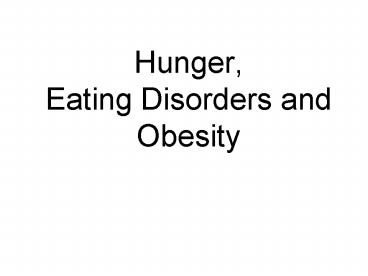Hunger, Eating Disorders and Obesity PowerPoint PPT Presentation
1 / 29
Title: Hunger, Eating Disorders and Obesity
1
Hunger, Eating Disorders and Obesity
2
Set Point Theory
- The point at which an individuals weight
thermostat is supposedly set. - When the body falls below this weight, an
increase in hunger and a lowered. - Metabolic rate may act to restore the lost
weight.
3
Basal Metabolic Rate
- Bodys base rate of energy expenditure when at
rest. - Calorie input vs. Calorie output
- 3500 calories in 1 pound of fat!! Yum, Yum!
4
Stomach contractions accompany our feelings of
hunger
Subject presses key each time He feels hungry
Subject swallows balloon, which measures
stomach Contraction
(Washburn, 1912)
5
The hypothalamus controls eating and other body
maintenance functions.
6
Hypothalamus Hormones
The hypothalamus monitors a number of hormones
that are related to hunger.
7
Some Appetite Hormones
- Orexin
- Hunger triggering hormone secreted by the
Hypothalamus. - Ghrelin
- Hormone secreted by empty stomach.
- Im Hungry.
- PYY
- Digestive Tract Hormone.
- Im Full.
8
Leptin
- A hormone involved in hunger regulation is
leptin. - Fat cells in the body secrete leptin and release
it into the blood. - When the leptin level in the blood is high,
hunger decreases.
9
Hypothalamic Centers
The lateral hypothalamus (LH) brings on hunger
(stimulation). Destroy the LH, and the animal has
no interest in eating. The reduction of blood
glucose stimulates orexin in the LH, which leads
rats to eat ravenously.
10
Hypothalamic Centers
The ventromedial hypothalamus (VMH) depresses
hunger (stimulation). Destroy the VMH, and the
animal eats excessively.
Richard Howard
11
Glucose C6H12O6
- The glucose level in blood is maintained. Insulin
decreases glucose in the blood, making us feel
hungry.
Glucose Molecule
12
Glucose the Brain
- Levels of glucose in the blood are monitored by
receptors (neurons) in the stomach, liver, and
intestines. They send signals to the hypothalamus
in the brain.
Rat Hypothalamus
13
Glucose
- The form of sugar that circulates in the blood
stream. - Provides the major source of energy for body
tissues. - When its level is low, we feel hunger.
14
Insulin
- Insulin allows cells to access glucose in the
blood. - When the pancreas secretes insulin, hunger
increases.
15
Diabetes
- Diabetes is a condition caused by a deficiency of
insulin. - The cells in the body are not able to access the
glucose in the blood. - Type 1
- Type 2
16
Social Impact of Hunger
- Body Image
- Eating Disorders
17
(No Transcript)
18
Anorexia Nervosa
- When a person is less than 85 of their normal
body weight. - 95 of sufferers are female, most are between the
ages of 18-30 and Caucasian. - Approximately 20 of persons diagnosed with
anorexia nervosa die.
19
Bulimia Nervosa
- Disorder characterized by episodes of overeating,
usually of highly caloric foods, followed by - vomiting
- laxative use
- fasting
- excessive exercise
20
Cathy Rigby Little Girls in Pretty Boxes
- "When I hit puberty and went up to about 104
pounds two or three months later, I worked a
little harder at either starving myself or
becoming bulimic."
The first American woman to win a medal in World
Gymnastics competition. She holds 12
international medals, eight of which are gold.
While Cathy excelled in the Olympics, she also
suffered from an eating disorder.
21
Reasons for Eating Disorders
- Sexual Abuse Childhood sexual abuse does not
cause eating disorders. - Family Younger generations develop eating
disorders when raised in families in which
weight is an excessive concern. - Genetics Twin studies show that eating disorders
are more likely to occur in identical twins
rather than fraternal twins.
22
Environmental Factors
- Availability of rich foods
23
Environmental Factors
- Preferences
- Conditioning, Observational Learning
- Supersize Me
24
Environmental Factors
- Stress
25
Environmental Factors
Portion Size
- Cultural attitudes
- Ideal Body Size
26
Obesity
- 65 of Americans, according to the Center for
Disease Control - High risk of early death
- Diabetes (Type 2)
- Heart Conditions
- Lack of Exercise
27
Social Impact of Obesity
- Obese people are less likely to be
- Married
- Happy
- Make Money (7,000 less than thinner people with
same qualifications)
28
Physiology of Obesity
- Fat Cells
- Typical adult has about 30 million fat cells.
- They can divide into more
- They will not disappear
29
Summary

